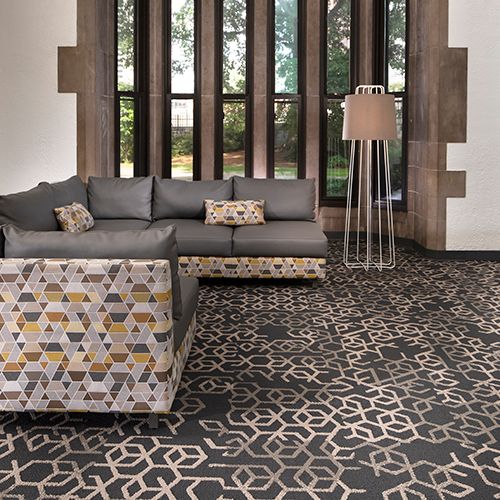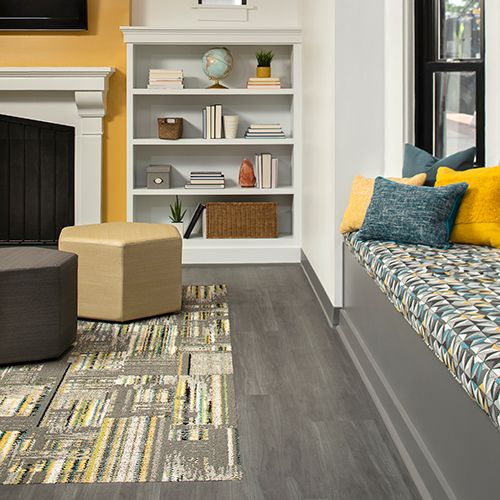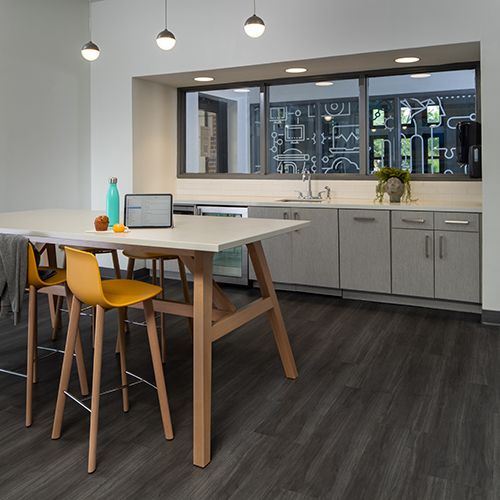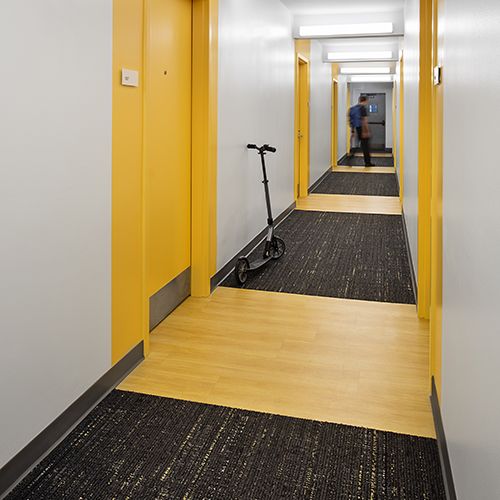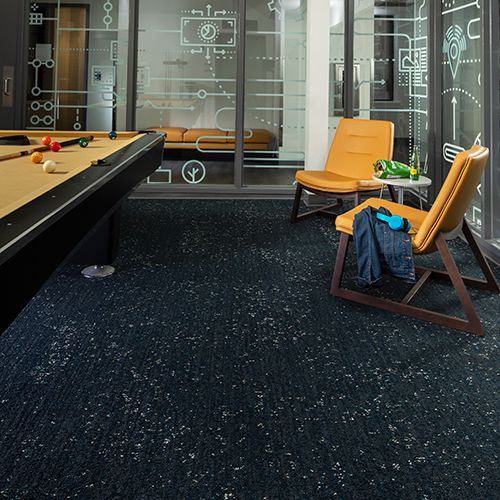In January 2020, Georgia Institute of Technology began the process of renovating its Harris and Smith residence halls to foster a more dynamic student living experience. An active campus with more than 32,000 students, Georgia Tech’s Facilities Design and Construction team was accustomed to working under tight deadlines. However, this project was made more complex by the onset of the COVID-19 pandemic. Supported by vibrant, durable flooring solutions and timely delivery by Interface, Georgia Tech created fresh, exciting housing options for its undergraduates while maintaining the integrity of two historical campus buildings.
Overdue Renovations Yield New Opportunities
The decision to renovate Georgia Tech’s Smith and Harris residence halls came in January 2020 as a result of feedback from the people most familiar with the spaces – the students. A student representative presented their concerns about the dormitories to the Facilities Design and Construction team, confirming that this renovation was overdue. “We knew that it was time for a change in these spaces, and the student body confirmed that something needed to be done,” said Polly Patton, Senior Interior Designer. “The corridors felt very dark and heavy. Collectively, we wanted them to feel lighter, more accessible and comfortable. More like home.”
The renovations originally intended to cover the buildings’ common spaces – lounges, corridors, and the fitness center. However, the pandemic presented an opportunity to do more. “As the residence halls were empty, we realized we could renovate the dorm rooms as well,” explained Patton. “The carpet in Harris Hall’s rooms was about 30 years old, and this was our opportunity to freshen it up.”
Renovating Under Pressure
When Georgia Tech’s Facilities Design and Construction team began work to renovate Harris and Smith, they knew they were working against the clock. “We really had to hit the ground running. We received the request on January 31, 2020, and conducted our assessment on February 2 and 3,” said Patton. “Knowing our scope and given timeline, we were already behind.”
To make things more complicated, the Georgia Tech campus went under lockdown just a few weeks later as a result of the COVID-19 pandemic, preventing all but essential employees from working on campus. “I was classified as an essential employee, but the local design firms I might typically work with were not able to come on campus due to COVID-19 protocols,” Patton said. “We weren’t able to be in the same room working together, pulling samples, etc.”
Fortunately, Interface was able to help by removing some of the complexities of remote flooring selection. Leveraging its Virtual Project Team, a curated set of resources to support designers at any stage of the flooring design and installation process or fully from concept to completion, Interface shipped sample products directly to customers’ homes so that projects could continue while teams worked remotely. “The designers had samples shipped directly to their houses, so they were able to mock up concepts and themes from afar,” Patton explained. “Then I was able to take those concepts, marry my own ideas and work with my Interface sales reps to put in our order quickly. There wasn’t time to go back to the drawing board or slow down and reconcept. We had to keep moving.”
Timing of delivery and installation also weighed heavily on the Georgia Tech team, as they knew the pandemic was affecting many manufacturers’ operations. “That’s always a worry because everyone across the country could be ordering at the same time, and we knew Interface was still very busy at the mill,” Patton said. “When it came to sourcing and ordering, I asked my Interface reps what was available. They worked to ensure that everything was delivered and installed on time, and it turned out very well.”
“The project ran smoothly despite the challenges of COVID-19,” added Shelby Eanes, Interface Account Executive. “We were able to finish installation in late summer 2020, just before students returned to campus for the fall semester.”
Durability and Cleanliness Without Compromising Design
Georgia Tech selected Interface luxury vinyl tile (LVT) for the dorm rooms to complement the carpet tile chosen for the corridors. “LVT is a great option to support cleanliness and durability. You can better see dust and dirt, and a light wet mop is all that you need to keep it clean – ideal for busy college students,” said Patton. “It also allows students to bring their personalities into the space, such as a personal rug or other décor. The LVT’s neutral gray complements those unique choices rather than competing with them.”
In the corridors, Patton sought to create an experience akin to a boutique hotel. “Carpet tile in the corridors allows for soft transitions that feel more like home,” she said. “The tiles also add a great pop of color, allowing us to breathe life and brightness into the space, supported by fresh paint and improved LED lighting. In Harris Hall, we were able to use a different colorway on each floor – an exciting wayfinding tool that also supported the dynamic living environment we were looking for.”
The team also took acoustics into account, noting that limiting the transmission of sound was crucial for healthy living environments. “Interface LVT and carpet tile offer effective acoustics solutions,” said Eanes. “So not only does the flooring perform well and look good, but it supports acoustic needs as well.”
Perhaps the most important benefit of Interface flooring solutions in higher education housing is its durability. “Interface offers great products with high durability, which is important when you are not planning to switch out a product for 15 years or more,” said Patton.
Better for Students, Better for the Environment
Georgia Tech’s sustainability commitment includes embracing a transformative process where everyone is responsible for making choices that promote the health, human security, and well-being of today’s, and tomorrow’s, society. The University recognizes that sourcing sustainability-minded materials for its building and design projects contributes to that process. By choosing Interface’s flooring products, which are all carbon neutral across their full product life cycle through its Carbon Neutral Floors™ program, Georgia Tech reduced the carbon footprint of these spaces. In fact, the more than 2,200 square yards of Interface installed in Smith and Harris halls resulted in the retirement of 29 metric tons of carbon dioxide, equivalent to the emissions from a car traveling almost 72,000 miles.
